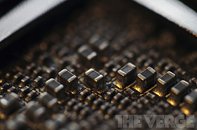Wednesday, December 21st 2011
Self-Repairing Circuits On The Horizon, Skynet, Here We Come
Engineers at the University of Illinois have developed what they claim to be "self-repairing electronic circuits", which have the ability to restore broken circuits, and restore the functionality of whatever uses them. The technology works at the level of the PCB design, countless microscopic capsules filled with liquid metal are placed along with everything else, as the circuit board is being made. When the circuit is broken at a point, those micro-capsules break, and the secreted liquid metal gets channeled into the path of the broken portion of circuit, closing it back up (restoring it). This happens at a very small and localized scale, and dramatically increases MTBF (mean time before failure), if done right.
The researchers behind this technology call it an excellent solution for electronics that are supposed to be fail-safe, such as avionics, electronics running commercial aircraft, so broken circuits could fix themselves mid-air, and become operational within microseconds. Terms like "self healing electronics" and "liquid metal" instantly bring back pop-culture references to Hollywood epics such as the Terminator, and its dystopian future brought about when one of those self-healing circuits is also made "self-aware". And no, those are just surface-mounted capacitors in the picture.
Sources:
The Verge, Wiley Online Library
The researchers behind this technology call it an excellent solution for electronics that are supposed to be fail-safe, such as avionics, electronics running commercial aircraft, so broken circuits could fix themselves mid-air, and become operational within microseconds. Terms like "self healing electronics" and "liquid metal" instantly bring back pop-culture references to Hollywood epics such as the Terminator, and its dystopian future brought about when one of those self-healing circuits is also made "self-aware". And no, those are just surface-mounted capacitors in the picture.

26 Comments on Self-Repairing Circuits On The Horizon, Skynet, Here We Come
There are different alloys that either are liquid at room temperature, or stay solid at higher temps.
The the channel is littered with those lil Gallium eggs. In theory I guess it would never have to become solid again as it would be trapped in the channel. I mean IMO its not a permanent solution but its a great safety net.
this seems to be tech to repair PCB damages, not solder damages.
A.) There are two different capsules. One with the Gallium substance and another with another chemical. When the capsules are broken the Gallium flows into the broken circuit, and the second chemical causes it to harden after certain amount of time, giving the Gallium enough time to flow into the break.
B.) The surface of the circuit is coated in a chemical that reacts with the Gallium substance and causes the Gallium to harden once the capsule is broken.
C.) The electric current flowing through the circuit causes the Gallium substance to harden. The substance would obviously have to reactive to this type of thing, and I don't know if that is possible(though this might be part of their breakthrough).
They already have self healing car paint.:D